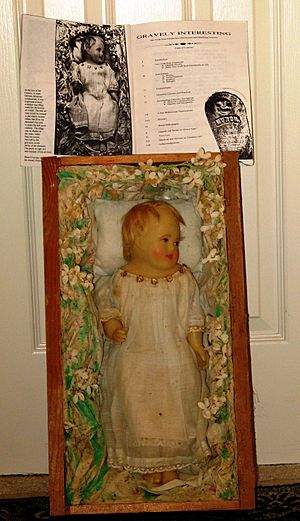Victorian mourning dolls facts for kids

During the mid-1800s to early 1900s, known as the Victorian Era, people had special ways to remember loved ones who had passed away. Back then, most deaths happened at home. Families would prepare the body and often display it in their house for a while. Because death was so close to home, and many babies and children didn't survive, kids often saw and understood death from a young age. By the late 1800s, a custom grew to make "mourning dolls." These dolls were placed at the grave of a child who had died. They became a popular way for families to cope with their sadness.
Contents
Dealing with Loss in the Victorian Era
How Children Understood Death
In the Victorian Era, people talked openly about death with children. It wasn't a scary topic. Children's stories often included scenes about death. These stories usually focused on the happiness of heaven. They also talked about how families would meet again there someday.
What Were Grave Dolls?
Creating Wax Effigy Dolls
People had many ways to remember loved ones after they passed. Some took photos of the deceased. Others made art from hair. Grave dolls were another special way. Parents could create a doll that looked like their child. This helped them remember their little one.
When a child died, families who could afford it would have a life-sized wax effigy made. This doll was for the funeral. The doll often wore the child's own clothes. Most of the child's real hair was used to make the doll look even more real.
What Did They Look Like?
These wax dolls usually showed the child lying down. They looked like they were in a small coffin. Their eyes were closed, as if they were peacefully sleeping. The back of the doll's head was flat. This helped the doll lie nicely when displayed.
The effigy doll was shown at the wake. A wake is a gathering before the funeral. After the wake, the doll was often left at the grave site. However, some of these wax dolls still exist today. This tells us that some families kept them.
How Were They Used?
Wax dolls of babies might be placed in a crib. Their clothes would be changed. They were treated almost like a real baby. The bodies of these wax dolls were made of cloth. They were weighted with sand. This made them feel more realistic. Sometimes, the doll itself would be put in a picture frame. For older children, only the head and shoulders were made into a wax effigy. These also had flat backs. This way, they could be placed in a picture frame.

